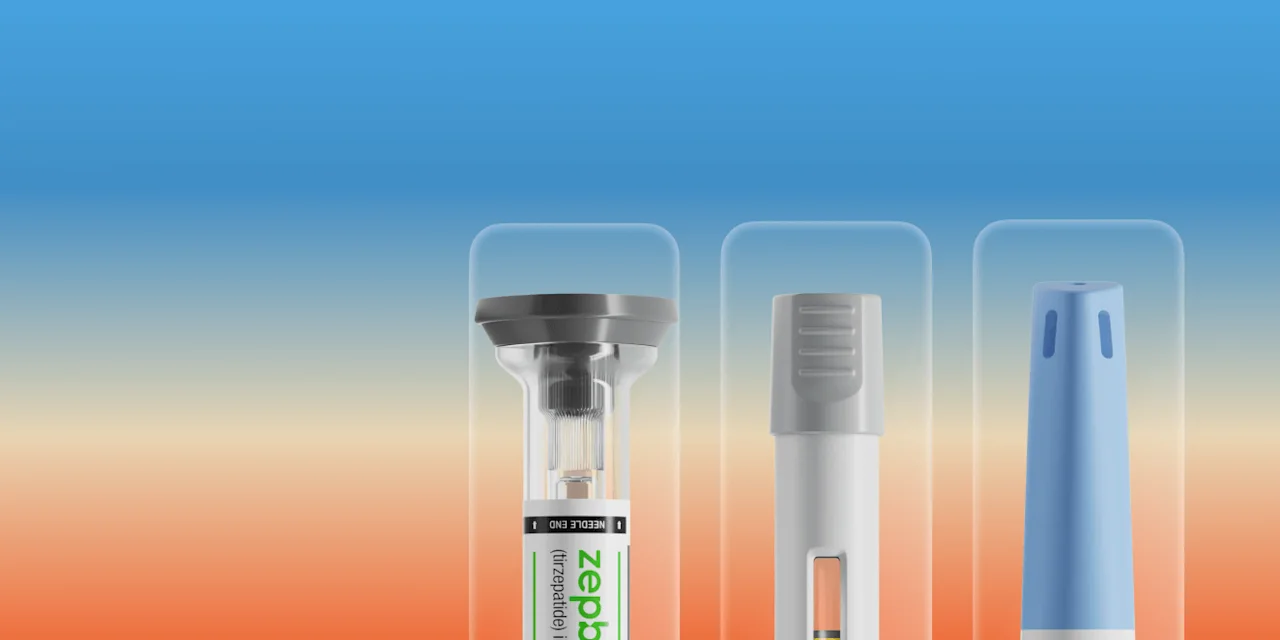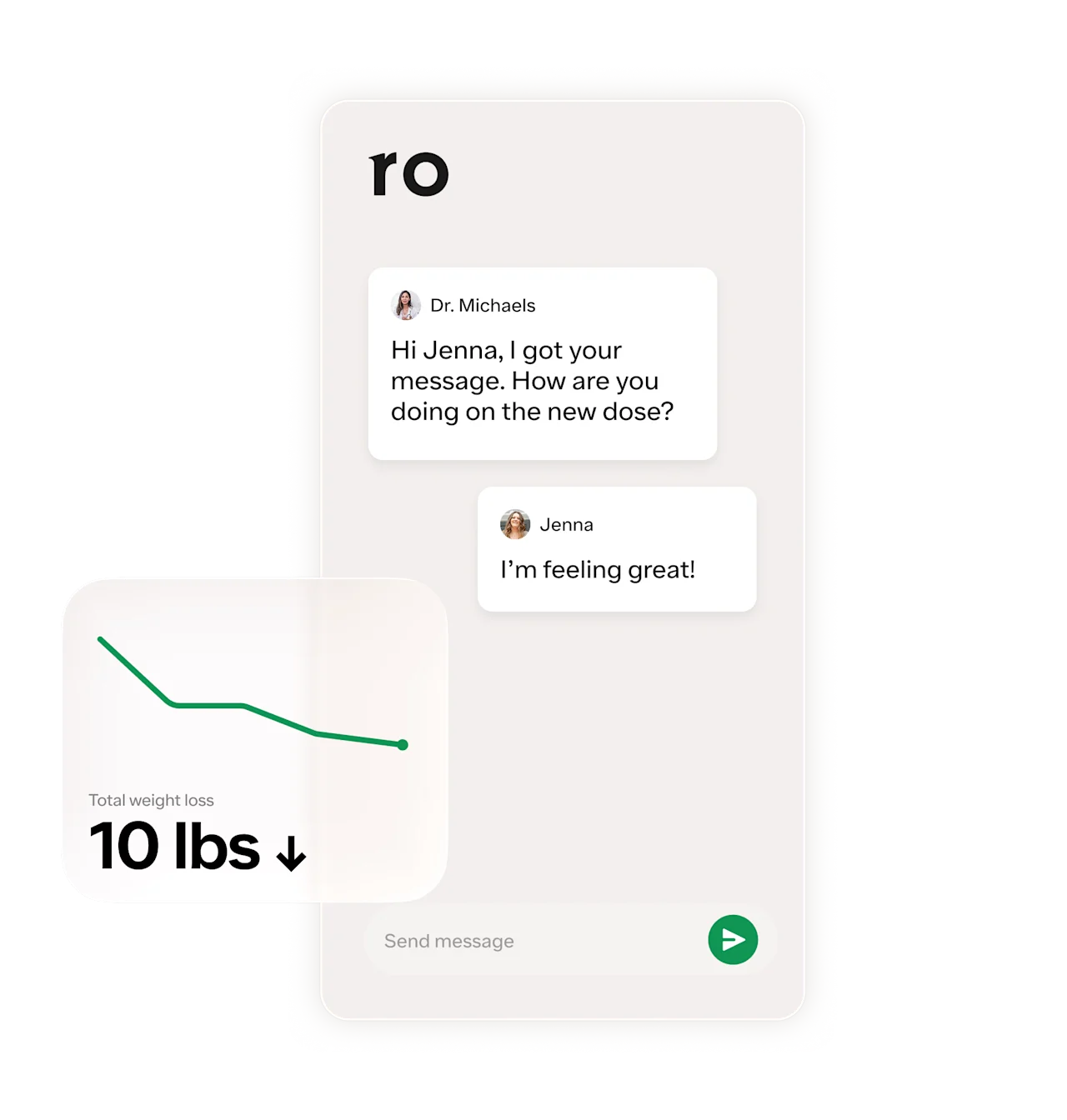Key takeaways
Though not approved for weight loss, Ozempic (semaglutide) is often prescribed off-label for that purpose because it reduces appetite and slows gastric emptying, which can ultimately lead to weight loss.
While average weight loss on Ozempic varies from person to person, in clinical trials, participants lost 13–15 pounds in the first 10 months of taking the drug.
How much weight you can lose on Ozempic depends on several factors, including dosage, starting weight, physical activity levels, diet, and more.
Here's what we'll cover
Key takeaways
Though not approved for weight loss, Ozempic (semaglutide) is often prescribed off-label for that purpose because it reduces appetite and slows gastric emptying, which can ultimately lead to weight loss.
While average weight loss on Ozempic varies from person to person, in clinical trials, participants lost 13–15 pounds in the first 10 months of taking the drug.
How much weight you can lose on Ozempic depends on several factors, including dosage, starting weight, physical activity levels, diet, and more.
Since Ozempic (semaglutide) became a popular off-label option for people trying to lose weight, there have been dramatic reports from patients about their impressive weight loss while using the medication and others like it. But just how much weight can you lose on Ozempic, actually?
Before answering that question and going into the average weight loss on Ozempic, it’s important to note that the drug is not actually indicated for weight loss. Rather, Ozempic is approved by the US Food and Drug Administration (FDA) to control blood sugar in people who have type 2 diabetes and to reduce the risk of major cardiovascular events (e.g. heart attack, stroke) or worsening kidney disease in those with type 2 diabetes and heart disease or chronic kidney disease. Still, however, the drug can be (and often is) prescribed off-label for weight loss. That’s largely thanks to its appetite-suppressing and slowed gastric emptying effects.
So, back to the matter at hand: How much weight can you lose on Ozempic? Ahead, we answer that question by reviewing the average weight loss on Ozempic, according to research. We also share tips on how to maximize weight loss on Ozempic depending on your goals.
How much weight can you lose on Ozempic?
In clinical trials of Ozempic, which is one brand-name version of the drug semaglutide, 37%–66% of people lost at least 5% of their body weight, and 13%–26% of people lost at least 10% of their body weight while taking the medication. Meanwhile, another study found that people lost an average of 13–15 pounds in the first 10 months of taking the drug. Although these findings are impressive, how much weight you can lose on Ozempic is different for everyone.
Factors that affect how much weight you can lose on Ozempic include whether or not you have type 2 diabetes, the dose, your weight upon starting the drug, and whether or not you implement lifestyle modifications (e.g. diet, exercise).
People who have type 2 diabetes, for example, tend to lose less weight when treated with semaglutide than people without the condition. Also, the amount of weight a person loses while using Ozempic tends to be dose-dependent. In other words, in clinical trials, people taking lower doses lost less weight than participants taking increasingly higher doses. Typically, when starting Ozempic and similar medications, healthcare providers will have patients begin on lower doses and slowly titrate up to minimize side effects from the drug.
All in all, Ozempic and other semaglutide medications produce significantly more weight loss than diet and exercise alone. In one study comparing semaglutide to a placebo, those who took the placebo lost less than 4% of their body weight during a period of 68 weeks, while those taking semaglutide lost almost 10%.
Whether you are taking Ozempic to manage type 2 diabetes, weight, or both, it’s important to remember that the medication is most effective when combined with lifestyle changes, such as diet and exercise.
How quickly does Ozempic work for weight loss?
Ozempic starts working as soon as you start taking the medication. For some people, that means they start seeing results fairly quickly. Studies show that people tend to start eating less during the day, experience fewer cravings, and lose an average of 11 pounds, all within the first three months of taking Ozempic.
How much weight can you lose in a month on Ozempic?
“In the primary study of semaglutide for obesity, people lost weight as early as four weeks, about an average of 2% or 4.4 pounds,” says Beverly Tchang, MD, DABOM, Ro Obesity Medicine Advisor and assistant professor of Clinical Medicine at Weill Cornell Medicine in New York. “However, the first four weeks uses the lowest starting dose of semaglutide, 0.25 mg, which does not induce significant weight loss in many people. So, if you don't see weight loss in the first four weeks, that can be normal too.”
Translation: It’s difficult to determine how much weight you can lose in a month on Ozempic. That being said, we can consider additional findings, such as those from a 2022 clinical trial, and do some math. In this trial, 175 individuals with overweight or obesity received a weekly dose of 1.7 mg or 2.4 mg of semaglutide (the active ingredient in Ozempic). The mean baseline weight (i.e. participants’ average starting weight) was 118.1 kg or 260.4 pounds. After three months, participants had lost an average of 5.9% of their body weight, which in this study represented around 14 pounds. By rough approximations, this breaks down to about 5 pounds per month, though it’s possible some people lost more weight near the beginning of the period and other people near the end.
And that, dear readers, is around the same monthly average weight loss on Ozempic that Dr. Tchang mentions above. So, while there’s no universal answer and everyone’s experience is different, it’s likely safe to assume that you can lose around 4–5 pounds in a month on Ozempic, according to research.
How does Ozempic work?
Ozempic is a glucagon-like peptide-1 (GLP-1) receptor agonist, a type of medication that mimics the GLP-1 hormone naturally found in the gut. Meaning, it binds to GLP-1 receptors and encourages the pancreas to release more insulin after you eat, which helps lower and stabilize blood sugar levels. Ozempic also positively impacts blood sugar levels by inhibiting the production of glucagon (a hormone that makes you feel hungry).
Although these effects make Ozempic an effective medication for type 2 diabetes, stabilizing blood sugar isn’t all the drug can do. As a GLP-1, Ozempic slows gastric emptying, so it takes longer for food to leave the stomach and enter the small intestine. Because of this effect, people taking the medication may feel full sooner and stop eating, which can contribute to weight loss. There’s also evidence that Ozempic and other GLP-1 agonists like it have an effect on the parts of your brain involved in regulating your appetite, suppressing appetite and increasing satiety (fullness).
How to maximize weight loss on Ozempic?
There are several things people can do to maximize weight loss on Ozempic, from adapting certain lifestyle changes to addressing underlying health issues.
1. Change what you eat
As is the case for achieving weight loss goals sans medication, your diet can play an important role in how much weight you can lose on Ozempic. And while nothing is “off limits,” there are certain foods and drinks you might want to limit to help reduce digestive side effects and promote weight loss.
Fried, greasy foods, for example, can cause gastrointestinal upset on their own. Add into the mix Ozempic, whose side effects are largely stomach-related, and you may increase your odds of experiencing nausea, bloating, and gas. These foods also tend to be high in calories and trans fats, with research linking fried food intake to obesity.
Sugary foods and beverages, such as soda and candy, can lead to overeating and weight gain, according to research. They can also pose additional problems for those working to manage type 2 diabetes, as sugar quickly spikes blood sugar levels, and these spikes can have negative impacts on insulin sensitivity. This can counteract the potential effects of Ozempic.
When you’re aiming for certain weight loss goals, consuming fewer calories—while keeping up with regular physical activity—can help you achieve or maintain a healthy weight. So, consider limiting foods high in empty calories but low nutrition (think: salty, sugary, fatty, and processed items) and eating fiber-full and protein-rich foods that increase satiety (e.g. fish, nuts, seeds, fruits, veggies) instead.
Doing this can be easier said than done (hey, we get it). So, if you’re having difficulty getting enough protein, for example, Dr. Tchang says replacing one of your meals with a protein shake could be a good option. Not only do they pack in a ton of the macronutrient (which boosts feelings of fullness), but they’re also portion-controlled, so you know you’re getting the optimal amount of calories needed. Try to make sure your protein shake doesn’t pack large amounts of added sugar that might interfere with your diet.
2. Change how you eat
Ozempic works best when combined with diet and exercise. Now that we’ve covered how eating less can help maximize weight loss on Ozempic, let’s talk about how eating better can help too.
For example, research shows that engaging in mindful eating can help you become more in tune with your body’s hunger cues, so you only eat when you’re actually hungry vs. out of habit or stress. Mindful eating is pretty straightforward. You can start by eating without distractions (i.e. not at your desk or in front of the TV) and focusing on how the food tastes and feels in your mouth.
Ozempic in combination with a healthcare provider, dietitian, or nutritionist’s advice can be another great way to maximize your weight loss efforts, adds Dr. Tchang. “In one clinical trial of Ozempic, about 1 in 3 people achieved at least 20% weight loss (or about 37 pounds on average) with a combination of meal replacement protein shakes, a low-calorie diet (1,200-1,800 calories/day depending on your body’s needs), physical activity (slowly ramped up to 200 minutes per week), and multiple visits with a dietitian-nutritionist.”
Through Ro’s Body membership, for example, you can receive access to ongoing care and support that helps you navigate your weight loss journey and get the most out of your treatment.
3. Add in exercise
Maintaining a regular workout routine is an essential component of achieving any weight loss-related goals. And that’s true when you’re taking Ozempic.
As Dr. Tchang notes earlier, at least 200 minutes of physical activity per week is key to prevent weight gain and maintain weight loss on Ozempic. Not yet able to do 200 minutes per week? No problem. Try to do whatever amount of exercise that you can stick with and grow your habit from there.
That being said, certain types of exercise can be especially beneficial if you’re taking Ozempic. Resistance training, for example, can not only help you build and maintain muscle—which is key for weight loss—but it can also help improve blood sugar over time—a pro for those taking Ozempic for diabetes. Meanwhile, a combination of cardio and strength training can also supercharge your ability to burn fat, build muscle, and, in turn, lose weight. (Keep in mind: the more muscle you have, the more energy or calories your body can burn during the day.)
4. Stress less, sleep more
Another example of easier said than done, right? But taking care of your mental health and prioritizing sleep really does matter, especially when it comes to weight loss.
When you’re feeling stressed, you’re more likely to turn to high-fat, high-sugar, and high-calorie foods. Stress also makes it tougher to sleep and can even mess with hormone production—including the hormones involved in regulating your appetite.
Poor sleep, whether you’re not getting enough sleep or the sleep you get is characterized more by tossing and turning all night, is also linked to weight gain. People who are sleep-deprived tend to turn to the same high-calorie, low-nutrition foods that stressed-out folks do. They’re also more likely to snack. Meanwhile, people who get better sleep tend to lose more weight.
So, if you’ve been feeling stressed or exhausted (or maybe a bit of both), consider what steps you can take to sleep better and relax. Make sure you have room to get at least 7–9 hours of sleep per night and prepare for rest with a relaxing bedtime routine. Mindfulness-based exercises, including meditation, yoga, and deep breathing, can ease stress. And if things start to feel like too much, consider reaching out to a therapist for help.
5. Manage other health conditions
If you have other health conditions that might be slowing down your weight loss efforts—such as chronic pain or polycystic ovary syndrome (PCOS)—treating them can make things easier.
For example, if you’re taking Ozempic for type 2 diabetes, Dr. Tchang recommends checking in with your healthcare provider about your treatment plan. “Be sure to speak to your doctor about other medications you are taking for diabetes since some can cause weight gain, like sulfonylureas and insulin,” she says. “Optimizing your medication regimen to avoid weight-promoting medications while still keeping diabetes under control is key.”

Side effects of Ozempic
Like any prescription medication, Ozempic can cause side effects. The most common side effects of Ozempic are gastrointestinal in nature and include:
Vomiting
Diarrhea
Abdominal pain
Serious side effects can also occur on Ozempic, although they’re more rare. These include:
Acute pancreatitis
Diabetic retinopathy (a complication of diabetes that causes vision changes)
Severe gastrointestinal reactions
Serious allergic reactions
Gallbladder or kidney problems
Pulmonary aspiration during general anesthesia or deep sedation
Some people may be more at risk of experiencing serious side effects when taking Ozempic, including people who take insulin or who have a history of gastroparesis or diabetic retinopathy. Share your full medical history and a list of all current medications with all of your healthcare providers prior to starting Ozempic. Starting Ozempic may mean you need to take lower doses of medications that lower your blood sugar to avoid hypoglycemia.
Bottom line
According to clinical trials, people taking Ozempic can lose up to 5%–10% of their body weight and sometimes more. Ultimately, however, the answer to the question, “how much weight can you lose on Ozempic?” varies from person to person.
The amount of weight you lose on Ozempic can depend on the dose, your starting weight, and other underlying medication conditions, such as type 2 diabetes.
Ozempic starts working quickly, with people noticing appetite changes and weight loss within the first three months of taking it.
There are many evidence- and expert-backed strategies for maximizing weight loss while taking Ozempic, from maintaining a healthy, balanced diet to getting continual support from a healthcare provider.
Frequently asked questions (FAQs)
Can I lose 50 pounds on Ozempic?
Depending on your starting body weight, adherence to treatment and lifestyle changes, and dose of Ozempic, it may be possible to lose 50 pounds on Ozempic. However, larger amounts of weight loss may be more likely with Zepbound (tirzepatide), another medication that’s been proven to produce the most average weight loss among GLP-1s to date. In a 72-week trial of tirzepatide, for example, participants up to 21% of their body weight, which is more than the weight loss for Ozempic. One study found about one-third of those taking tirzepatide lost 25% or more of their starting weight, which, depending on their starting weight, could amount to 50 pounds.
Zepbound Important Safety Information: Read more about serious warnings and safety info.
What is the average weight loss on Ozempic?
It’s common for people to lose at least 5%–10% of their body weight on Ozempic and sometimes more. People who take higher doses or who have higher initial body weights tend to lose more weight on Ozempic. The amount of weight loss one experiences on Ozempic can vary from person to person, depending on their dose of Ozempic, their commitment to lifestyle changes like diet and exercise, starting body weight, and other health conditions.
How long does it take to lose weight on Ozempic?
Ozempic starts working as soon as you start taking it, although it may take time to notice weight loss and appetite changes. Typically, people start feeling less hunger and fewer cravings within the first three months of taking Ozempic. Studies have found people lose anywhere between 11–14 pounds, on average. Numbers can vary based on individual factors, such as your starting weight and whether you also have type 1 or type 2 diabetes.
DISCLAIMER
If you have any medical questions or concerns, please talk to your healthcare provider. The articles on Health Guide are underpinned by peer-reviewed research and information drawn from medical societies and governmental agencies. However, they are not a substitute for professional medical advice, diagnosis, or treatment.
Ozempic Important Safety Information: Read more about serious warnings and safety info.
References
Ahrén-a, B., Atkin, S. L., Charpentier, G., et al. (2018). Semaglutide induces weight loss in subjects with type 2 diabetes regardless of baseline BMI or gastrointestinal adverse events in the SUSTAIN 1 to 5 trials. Diabetes, Obesity & Metabolism, 20(9), 2210–2219. doi: 10.1111/dom.13353. Retrieved from https://www.ncbi.nlm.nih.gov/pmc/articles/PMC6099440/#dom13353-supitem-0001
Ahrén-b, B., Masmiquel, L., Kumar, H., et al. (2017). Efficacy and safety of once-weekly semaglutide versus once-daily sitagliptin as an add-on to metformin, thiazolidinediones, or both, in patients with type 2 diabetes (SUSTAIN 2): a 56-week, double-blind, phase 3a, randomised trial. The Lancet. Diabetes & Endocrinology, 5(5), 341–354. https://doi.org/10.1016/S2213-8587(17)30092-X. Retrieved from https://www.thelancet.com/journals/landia/article/PIIS2213-8587(17)30092-X/fulltext
Blundell, J., Finlayson, G., Axelsen, M., et al. (2017). Effects of once-weekly semaglutide on appetite, energy intake, control of eating, food preference and body weight in subjects with obesity. Diabetes, Obesity & Metabolism, 19(9), 1242–1251. doi: 10.1111/dom.12932. Retrieved from https://pmc.ncbi.nlm.nih.gov/articles/PMC5573908/
Cox, C. E. (2017). Role of Physical Activity for Weight Loss and Weight Maintenance. Diabetes Spectrum: A Publication of the American Diabetes Association, 30(3), 157–160. doi: 10.2337/ds17-0013. Retrieved from https://www.ncbi.nlm.nih.gov/pmc/articles/PMC5556592/
Davies, M., Færch, L., Jeppesen, O. K., et al. (2021). Semaglutide 2·4 mg once a week in adults with overweight or obesity, and type 2 diabetes (STEP 2): a randomised, double-blind, double-dummy, placebo-controlled, phase 3 trial. Lancet (London, England), 397(10278), 971–984. doi: 10.1016/S0140-6736(21)00213-0. Retrieved from https://pubmed.ncbi.nlm.nih.gov/33667417/
Frías, J. P., Auerbach, P., Bajaj, H. S., et al. (2021). Efficacy and safety of once-weekly semaglutide 2·0 mg versus 1·0 mg in patients with type 2 diabetes (SUSTAIN FORTE): a double-blind, randomised, phase 3B trial. The Lancet. Diabetes & Endocrinology, 9(9), 563–574. doi: 10.1016/S2213-8587(21)00174-1. Retrieved from https://pubmed.ncbi.nlm.nih.gov/34293304/
Ghusn, W., De la Rosa, A., Sacoto, D., et al. (2022). Weight Loss Outcomes Associated With Semaglutide Treatment for Patients With Overweight or Obesity. JAMA Network Open, 5(9), e2231982. doi: 10.1001/jamanetworkopen.2022.31982. Retrieved from https://jamanetwork.com/journals/jamanetworkopen/fullarticle/2796491
Guallar-Castillón, P., Rodríguez-Artalejo, F., Fornés, N. S., et al. (2007). Intake of fried foods is associated with obesity in the cohort of Spanish adults from the European Prospective Investigation into Cancer and Nutrition. The American Journal of Clinical Nutrition, 86(1), 198–205. doi: 10.1093/ajcn/86.1.198. Retrieved from https://pubmed.ncbi.nlm.nih.gov/17616781/
Hallare, J. & Gerriets, V. (2023). Half Life. StatPearls. Retrieved from https://www.ncbi.nlm.nih.gov/books/NBK554498/
Jensterle, M., Rizzo, M., Haluzík, M., & Janež, A. (2022). Efficacy of GLP-1 RA Approved for Weight Management in Patients With or Without Diabetes: A Narrative Review. Advances In Therapy, 39(6), 2452–2467. doi: 10.1007/s12325-022-02153-x. Retrieved from https://pubmed.ncbi.nlm.nih.gov/35503498/
Kotz, C. M., Perez-Leighton, C. E., Teske, J. A., et al. (2017). Spontaneous Physical Activity Defends Against Obesity. Current Obesity Reports, 6(4), 362–370. doi: 10.1007/s13679-017-0288-1. Retrieved from https://www.ncbi.nlm.nih.gov/pmc/articles/PMC5716862/
Mahapatra, M. K., Karuppasamy, M., & Sahoo, B. M. (2022). Therapeutic Potential of Semaglutide, a Newer GLP-1 Receptor Agonist, in Abating Obesity, Non-Alcoholic Steatohepatitis and Neurodegenerative diseases: A Narrative Review. Pharmaceutical Research, 39(6), 1233–1248. doi: 10.1007/s11095-022-03302-1. Retrieved from https://www.ncbi.nlm.nih.gov/pmc/articles/PMC9159769/
Mason, A. E., Epel, E. S., Aschbacher, K., et al. (2016). Reduced reward-driven eating accounts for the impact of a mindfulness-based diet and exercise intervention on weight loss: Data from the SHINE randomized controlled trial. Appetite, 100, 86–93. doi: 10.1016/j.appet.2016.02.009. Retrieved from https://pmc.ncbi.nlm.nih.gov/articles/PMC4799744/
O'Neil, P. M., Birkenfeld, A. L., McGowan, B., et al. (2018). Efficacy and safety of semaglutide compared with liraglutide and placebo for weight loss in patients with obesity: a randomised, double-blind, placebo and active controlled, dose-ranging, phase 2 trial. Lancet (London, England), 392(10148), 637–649. doi: 10.1016/S0140-6736(18)31773-2. Retrieved from https://pubmed.ncbi.nlm.nih.gov/30122305/
Papatriantafyllou, E., Efthymiou, D., Zoumbaneas, E., et al. (2022). Sleep Deprivation: Effects on Weight Loss and Weight Loss Maintenance. Nutrients, 14(8), 1549. doi: 10.3390/nu14081549. Retrieved from https://www.ncbi.nlm.nih.gov/pmc/articles/PMC9031614/
Parmar, R. M. & Can, A. S. (2023). Dietary Approaches to Obesity Treatment. StatPearls. Retrieved from https://www.ncbi.nlm.nih.gov/books/NBK574576/
Stinson, E. J., Piaggi, P., Ibrahim, M., et al. (2018). High Fat and Sugar Consumption During Ad Libitum Intake Predicts Weight Gain. Obesity (Silver Spring, Md.), 26(4), 689–695. https://doi.org/10.1002/oby.22124. Retrieved from https://www.ncbi.nlm.nih.gov/pmc/articles/PMC5866204/
Strasser, B. (2013). Physical activity in obesity and metabolic syndrome. Annals of the New York Academy of Sciences, 1281(1), 141–159. doi: 10.1111/j.1749-6632.2012.06785.x. Retrieved from https://www.ncbi.nlm.nih.gov/pmc/articles/PMC3715111/
Tomiyama, A. J. (2019). Stress and Obesity. Annual Review of Psychology, 70, 703–718. doi: 10.1146/annurev-psych-010418-102936. Retrieved from https://www.annualreviews.org/content/journals/10.1146/annurev-psych-010418-102936
U.S. Food & Drug Administration (FDA). (2025). Highlights of Prescribing Information: Ozempic (semaglutide). Retrieved from https://www.accessdata.fda.gov/drugsatfda_docs/label/2025/209637s025lbl.pdf
Wadden-a, T. A., Bailey, T. S., Billings, L. K., et al. (2021). Effect of Subcutaneous Semaglutide vs Placebo as an Adjunct to Intensive Behavioral Therapy on Body Weight in Adults With Overweight or Obesity: The STEP 3 Randomized Clinical Trial. JAMA, 325(14), 1403–1413. doi: 10.1001/jama.2021.1831. Retrieved from https://jamanetwork.com/journals/jama/fullarticle/2777025
Wadden-b, T. A., Chao, A. M., Moore, M., et al. (2023). The Role of Lifestyle Modification with Second-Generation Anti-obesity Medications: Comparisons, Questions, and Clinical Opportunities. Current Obesity Reports, 12(4), 453–473. doi: 10.1007/s13679-023-00534-z. Retrieved from https://pmc.ncbi.nlm.nih.gov/articles/PMC10748770/
Wilding, J. P. H., Batterham, R. L., Calanna, S., et al. (2021). Once-Weekly Semaglutide in Adults with Overweight or Obesity. The New England Journal of Medicine, 384(11), 989–1002. doi: 10.1056/NEJMoa2032183. Retrieved from https://www.nejm.org/doi/full/10.1056/NEJMoa2032183














